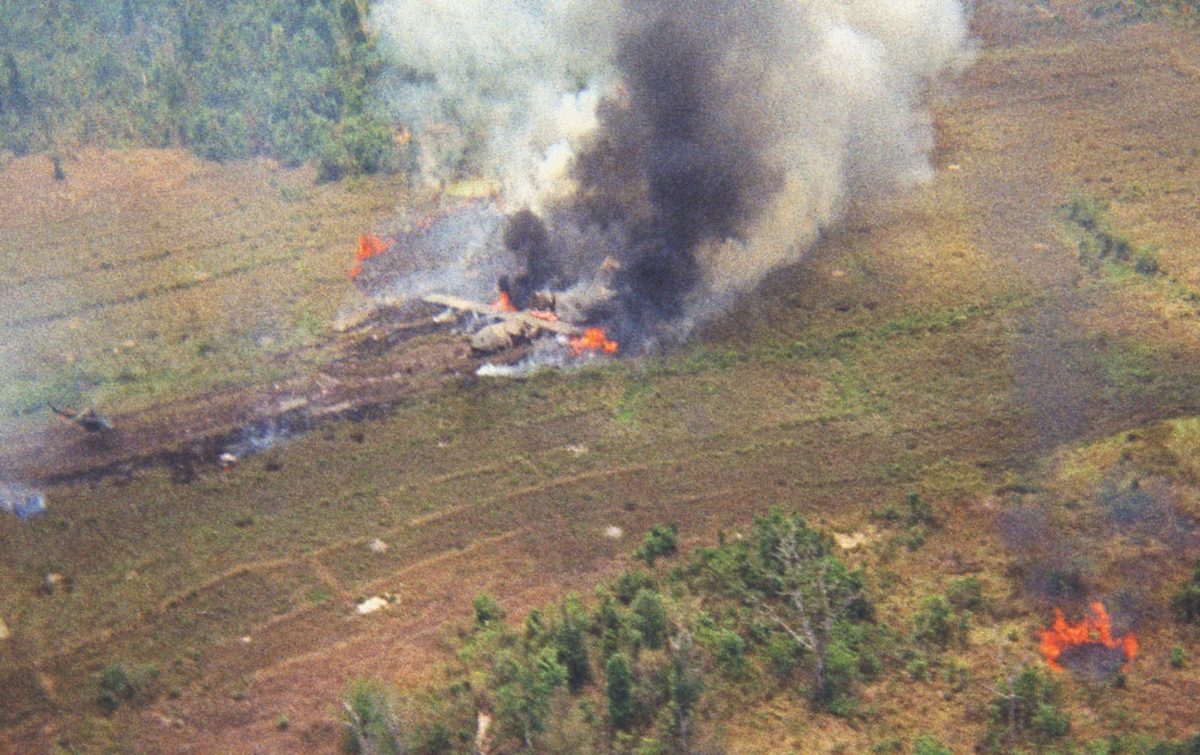The Lockheed C-130E Hercules transport plane flew south toward Saigon with its right wing low and its No. 3 engine trailing smoke and flame. The aircraft was losing altitude fast and wouldn’t get back to Tan Son Nhut Air Base. It was going down. Meanwhile, Saber Flight from Troop F, 1st Squadron, 9th Cavalry Regiment, was headed toward its Lai Khe staging base after a reconnaissance mission north of An Loc on April 18, 1972. As the crippled C-130 passed in front of his Huey, Capt. Robert Frank (call sign Saber 32), air mission commander, turned to his pilot in command, Chief Warrant Officer 2 Robert Monette (Saber 20), and exclaimed, “Wow! That looks like a bad day!” It was a classic understatement. Things were about to get worse.
A culmination of circumstances over the past few weeks had put the Hercules and Huey crews in this bad spot. On Thursday, March 30, Easter weekend, North Vietnamese Army troops swarmed into South Vietnam as they moved across the Demilitarized Zone and advanced eastward from Laos in the largest offensive at that point in the war. The Easter Offensive’s thrust into South Vietnam from the north was accompanied by assaults from Laos into the center of the country and from Cambodia into the southern region, threatening the capital at Saigon. The primary target in the southern area was An Loc, about 65 miles from Saigon.
Most of the fight against the communist invasion at An Loc and elsewhere during the Easter Offensive was waged by the Army of the Republic of Vietnam as a consequence of President Richard Nixon’s Vietnamization policy implemented in 1969. Vietnamization gradually transferred responsibility for combat operations to the South Vietnamese as American units were withdrawn. U.S. air support for South Vietnam continued, however.
In spring 1972, most Americans in ground combat roles were military advisers serving with South Vietnamese units. Only two big U.S. ground combat organizations remained in South Vietnam—the 196th Light Infantry Brigade at Da Nang in northern South Vietnam and the 3rd Brigade, 1st Cavalry Division (Airmobile), in the area between Saigon and Cambodia. Most of the 1st Cav had left Vietnam a year earlier, on March 26, 1971, and moved to Fort Hood, Texas.
By April 1, 1972, the 3rd Brigade consisted of three battalions of airmobile infantry, one battalion of 105 mm howitzers, beefed up with an extra battery of 105 mm howitzers, and a battery of rocket-armed helicopters from the 77th Field Artillery Regiment (Aviation) and the 2nd Squadron, 11th Armored Cavalry Regiment, which would leave Vietnam on April 6.
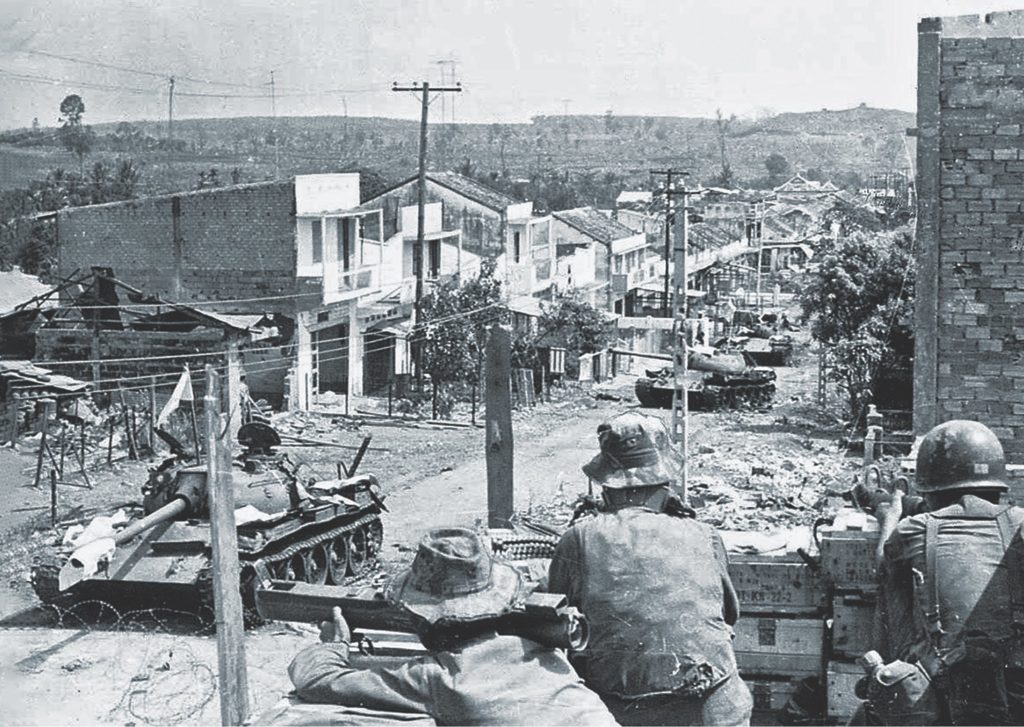
The 3rd Brigade also contained the 229th Aviation Battalion (Assault Helicopter), including Troop F, 1st Squadron, 9th Cavalry; helicopter Battery F, 79th Field Artillery Regiment (aerial rocket artillery); and 362nd Aviation Company (air assault). F Troop helicopters were assigned to perform reconnaissance missions north of their staging area, Forward Support Base Lai Khe, between Saigon to the south and An Loc to the north. Those missions were conducted through two subunits. Pink Teams and Blue Teams.
Pink Teams had two elements. The first was one low-flying scout helicopter that searched for communist forces or attempted to draw fire that revealed the enemy’s location. If the scout was fired upon, the second Pink Team element’s two helicopter gunships were called in to return fire. If the situation warranted it, the troop commander deployed Blue Teams of airmobile infantry to destroy the enemy in ground combat. This modernized version of the traditional horse cavalry provided unprecedented mobility and firepower.
At the time of the Easter Offensive, Pink Team scouts were flying UH-1 Hueys. Before the 1st Cavalry Division stood down, those crews were in OH-6A Cayuse light observation helicopters. A Pink Team scout element aboard a UH-1 consisted of a pilot, an aircraft commander and two door gunners/observers. The second Pink Team element flew two AH-1G Cobra gunships. The Blue Team troops were aboard UH-1 Hueys.
On April 5, communist forces in Cambodia drove into Binh Long province and attacked Loc Ninh, 12 miles from the border. The enemy force included the Viet Cong 5th and 9th divisions, the NVA 7th Division, the 24th and 271st independent regiments, the 69th Artillery Division, two battalions of the 203rd Tank Regiment and part of the 202nd Special Weapons Tank Regiment. The attacking force in Binh Long province aiming for An Loc had more than 35 maneuver battalions. Joining the invasion were armored vehicles, heavy anti-aircraft guns and surface-to-air missiles.
South Vietnamese forces astride Highway 13 at Loc Ninh were no match for the enemy’s overwhelming numbers. After a determined but unsuccessful defense, they were overrun on April 7. The ARVN commander had hesitated indecisively and neither reinforced his Loc Ninh forces nor withdrew them to bolster An Loc. Few survived. All seven U.S. advisers at Loc Ninh were killed or captured. Defeat of ARVN forces at Loc Ninh meant that the road to An Loc was wide open and Saigon was within reach. An Loc quickly became a “must win” battle for both sides.
The communists concentrated enough forces to meet or exceed the classical attackers-to-defenders ratio of 3-to-1. The wild card in the battle was the air power provided by the South Vietnamese and U.S. air forces. Their strength should have greatly improved the odds for An Loc’s defenders; however, the communists had learned costly lessons about the vulnerability of ground forces to air attack and brought to the battle weapons that improved their standing.
The NVA 69th Artillery Division could easily outmatch ARVN forces in ground-launched fire from both tube and rocket artillery. The division’s 271st Anti-Aircraft Regiment reduced the advantage of U.S. and South Vietnamese air power with 12.7 mm, 23 mm and 37 mm anti-aircraft weapons and the ZSU-57/2, a Soviet anti-aircraft vehicle with a pair of 57 mm cannons mounted on a T-54 tank chassis. The NVA also had a new anti-aircraft weapon, the SA-7 Strela shoulder-launched, heat-seeking guided missile. An Loc was an extremely dangerous place for U.S. and South Vietnamese planes.
Early in the siege, NVA forces cut off resupply from the south by severing Highway 13, the only viable road into the city. On April 8, they captured the Quan Loi airstrip, immediately to the northeast. An Loc was completely surrounded. Resupply from airplane landings was no longer an option, and helicopter landings were very risky. On April 12, a South Vietnamese CH-47 Chinook transport helicopter on a supply mission to An Loc was shot down. Airdrops became the only feasible way to get supplies to ground forces.
On the morning of April 13, An Loc was hit with heavy artillery shelling followed by a major NVA infantry assault, the beginning of a monthslong defensive struggle that ended when the communists finally gave up and South Vietnam declared the siege over on June 18.
From April 12 to 18, the South Vietnamese air force, equipped with C-119 Flying Boxcar and C-123 Provider transport planes, attempted to resupply An Loc by airdrop but had little success. Intense groundfire made low-level drops at 700 feet too dangerous, and drops from 5,000 feet too often missed the target. The An Loc drop zone was about 800-by-1,000 yards, with the city’s soccer field at its center.
From April 12 to 14, South Vietnamese aircraft flew 27 sorties trying to deliver 135 tons of supplies to An Loc’s beleaguered defenders. Only 34 tons reached friendly forces. The rest fell into enemy hands. One C-123 was lost to groundfire on April 14 and another on April 19. The U.S. Air Force 374th Tactical Airlift Wing’s Detachment 1 at Tan Son Nhut Air Base also participated in the resupply missions. Its first operation took place on April 15, when a C-130 delivered its load on the soccer stadium’s drop zone. However, that delivery required the aircraft to fly at the low level of 600 feet, well within the range of enemy anti-aircraft fire.
The second aircraft on the same mission, following not far behind on the identical route, was less fortunate. NVA anti-aircraft gunners were waiting. Before the second aircraft could reach the supply-release point, it was plastered by enemy fire in the cockpit and cargo hold. The co-pilot and navigator were injured. The flight engineer was killed. Incendiary rounds exploded ammunition in the cargo hold.
Loadmasters tried to extinguish the fire but were unsuccessful. They cut loose the load of ammunition and jettisoned it. Just in time—two pallets exploded in midair. The C-130 managed to return to Tan Son Nhut on two engines and crash-landed. The South Vietnamese had lost two C-123s, and the U.S. had one C-130 so badly damaged that it was questionable whether the plane would ever fly again.
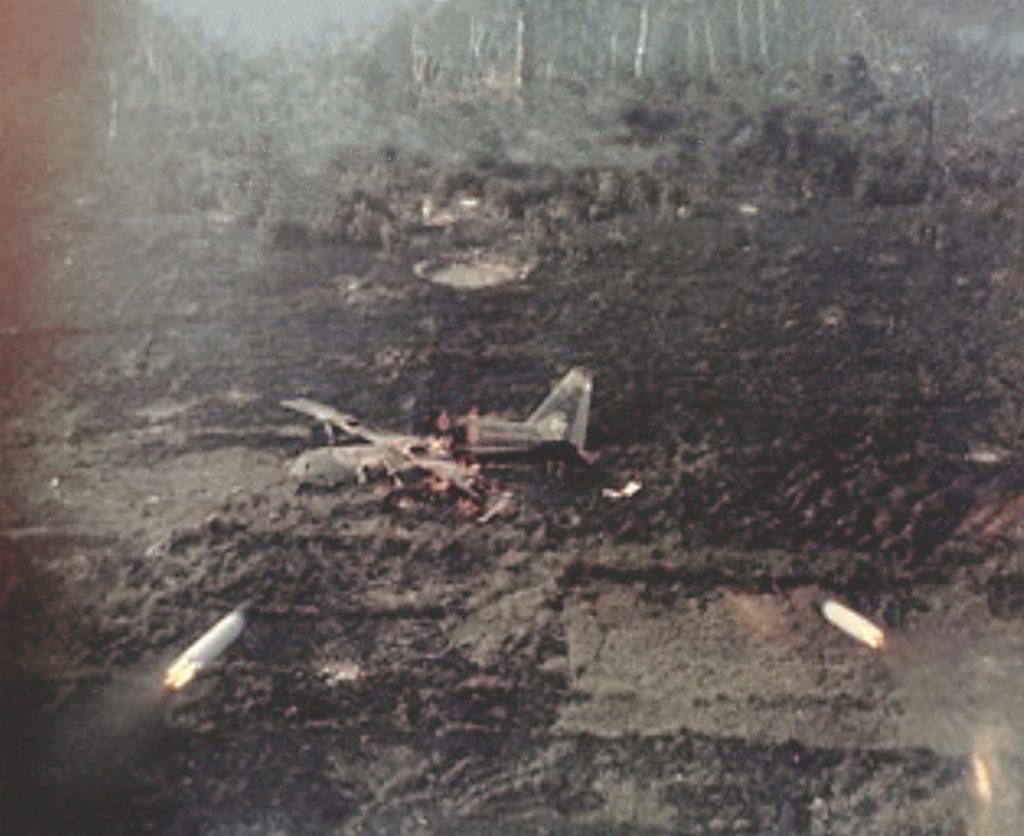
Low-level delivery wasn’t abandoned immediately, but other mission aspects changed. Routes to the drop zone were altered. Aircraft no longer flew directly up Highway 13 from the south. U.S. Air Force planners developed six different approaches to the drop zone, and “forward air controllers,” spotters flying ahead in small propeller-driven planes, advised the inbound supply planes on which route appeared less threatening.
Additionally, aircraft would no longer approach straight and level at 600 feet and about 150 mph. They would come in at high speed (nearly 300 mph) at treetop level, then execute a pop-up maneuver to 600 feet while bleeding off airspeed to enable release of a parachuted load. After release, the aircraft would accelerate and dive back to treetop level on the way home. The first attempt using the new tactics on April 16 missed the drop zone.
The next attempt was April 18 in a C-130 piloted by Capt. Don “Doc” Jensen and Maj. Leigh Pratt. Other crew members were Maj. Robert Kirkpatrick, navigator; Tech Sgt. Ralph Kent, flight engineer; Staff Sgt. Ralph Bemis, loadmaster; Sgt. Charles Armistead, assistant loadmaster (airdrops required two loadmasters); and ARVN Sgt. Nguyen Kiem. Jensen and Kent were part of the aircraft’s regular crew. Pratt and Bemis were members of the 374th Tactical Airlift Wing’s “standardization evaluation” team, which certified new crews and periodically renewed certifications for experienced crews. Kirkpatrick was a “guest navigator” acting as substitute for a regular in Hong Kong on R&R. Kiem was aboard to observe delivery of supplies to ARVN forces.
Early that morning riggers at Tan Son Nhut prepared ammunition loads, and loadmasters secured the supply bundles in Jensen’s C-130, tail number 63-7775, call sign Manta 75. The crew was soon airborne on its way to An Loc with the badly needed ammunition.
Takeoff at runway 24 Right was normal, but Kirkpatrick could not lock-on the navigation signals from Tan Son Nhut and nearby Bien Hoa Air Base. Fortunately, there was a distinguishable mountain peak north of An Loc that provided a good radar navigation landmark. Approaching An Loc, the crewmen conducted their usual 20-minute, 10-minute and 6-minute pre-drop checklists.
It was time to check in with the forward air controller, call sign “Sundog.” Surprisingly, he didn’t know about the mission. The Manta 75 crew had been told in a briefing that the C-130 flight would take place after a Boeing B-52 bombing mission, scheduled for noon. Sundog was busy coordinating that operation and other traffic. He finally cleared Manta 75 for a drop at 12:30 p.m., specifying a southeast to northwest approach.
Jensen descended to treetop level and maintained 300 mph to the “initial point,” the start of the run for the airdrop, where he executed the pop-up maneuver to 600 feet and decelerated to 150 mph.
This run-in included a surreal moment—the C-130 crewmen saw an NVA tank commander wave at them as they screamed over his head. They waved back.
At the 1-mile point, 30 seconds from the target, anti-aircraft fire pounded the ammunition and explosives-laden aircraft. The plane shuddered and caught fire. Bemis and Armistead, the loadmasters, scrambled to determine the damage. Armistead had been shot through the left arm but did not yet realize it.
The ammunition was on fire. Pilot Jensen’s connection to the plane’s internal phone system was shot away, but the co-pilot, the navigator and the two loadmasters were still able to communicate through the interphone. “Hold on,” navigator Kirkpatrick shouted. “We’re almost at the release point!” Bemis responded, “Load clear!”
With 15 tons of ammunition gone, the cockpit crew turned the plane south toward Tan Son Nhut. The loadmasters started assessing the condition of the stricken Hercules. Tan Son Nhut was 60 miles away, just 15 minutes of flight time. Bemis and Armistead could see that the nacelle enclosing the No. 3 engine had three .51-caliber holes, and engine oil was pouring out of them. The C-130 had taken at least one larger caliber round where the pylon-
mounted fuel tank would normally be. In the right wheel well was a hydraulic fluid fire that the two loadmasters were unable to extinguish.
They scrambled to the back and looked out the window on the right-side jump door where they saw the wing and No. 3 engine on fire. They watched the right flap separate from the wing and fall away. As they scurried forward again, an oxygen bottle exploded, as did the tires on the right landing gear. They told Pratt, the co-pilot, about the plane’s condition, but it was obvious the C-130 was not going to stay airborne for long. The cockpit crew struggled to keep the aircraft alive as it attempted to claw its way to a safer altitude.
Jensen summed up the aircraft’s situation in a 2018 Stars and Stripes article: “During the pull up just prior to dropping our cargo, we started taking ground fire and our right wing caught fire. The ground-fire intensity we encountered—approaching and departing—the An Loc area was incredible… We were fighting an in-flight fire, engine fire warnings, physical loss of flight control surfaces, electrical, hydraulic and pneumatic failures.”
Priority shifted from saving the aircraft to saving the crew, but all exits suitable for parachuting were jammed or engulfed in flames. Jensen would have to find somewhere to put the plane down. An Loc was surrounded by the enemy and ringed by rubber plantations where no clearings were large enough to land a C-130.
Jensen headed the plane toward Lai Khe, 20 miles to the south. But Manta 75, on fire and losing altitude, could not make it to the airfield. The loss of hydraulic and pneumatic power could cause complete loss of control, or the right wing spar could fail due to fire damage.
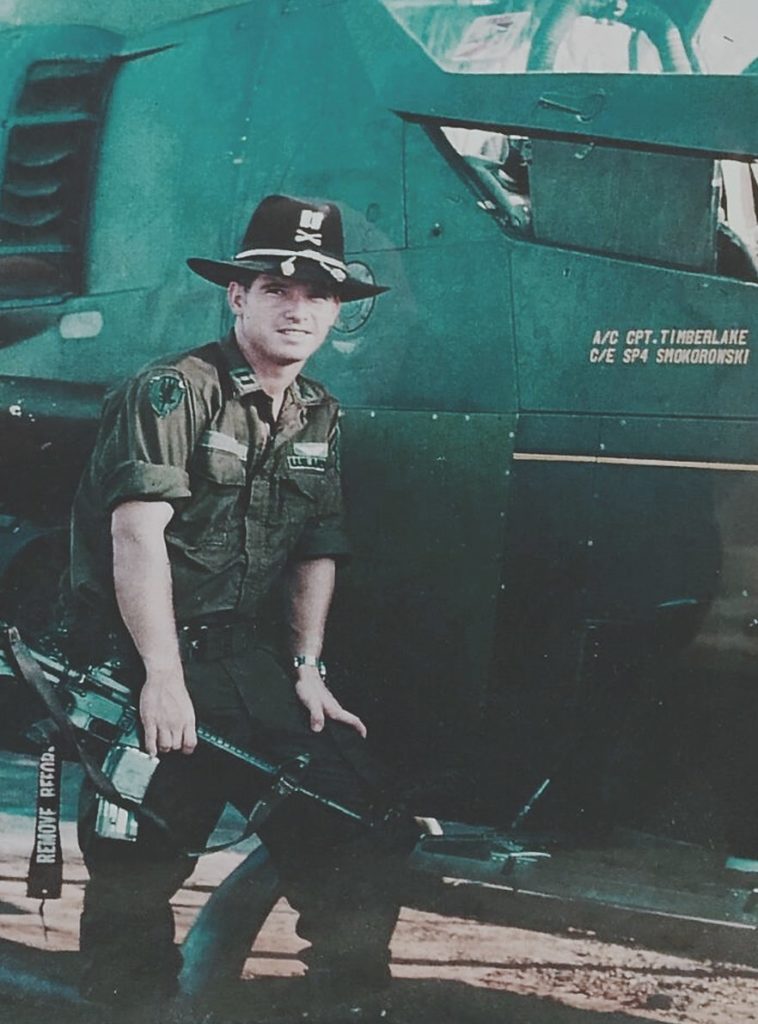
A clearing came into view. It would be a close call, but Jensen and Pratt felt they had no choice. At least the area was mostly open. Because of the damage to the interphone, the pilot and co-pilot communicated via hand signals. Jensen held full left rudder and aileron. Touchdown in a level position was critical to prevent cartwheeling uncontrollably if the right wingtip dug in. Just prior to touchdown, Pratt retarded the throttles for engines 1 and 2 and applied full power to the No. 4 engine to lift the right wing. The perfectly timed landing was level but violent.
The aircraft hit a tree and spun around 180 degrees with the nose pointing back along its flight path. The forward three quarters of the fuselage had separated from the tail section as the plane plowed through a field, spreading fire along the way. The C-130 finally stopped after a wild slide of about 1,000 yards. Flames surrounded the broken fuselage section.
Upon impact, the “dog trough”—the tray that ran along the top of the cargo area to hold radios—broke loose and struck Bemis, breaking his left arm and ankle and trapping him beneath a pile of debris at the partition separating the cargo area from the flight deck. Armistead rode out the crash at the buffer stop for the cargo and did not sustain any further injuries.
Frank’s Pink Team from F Troop, running visual reconnaissance missions in support of the ARVN forces and U.S. advisers in An Loc, had seen the fiery plane sinking across the sky as the team’s Huey and two Cobras were winding up their midmorning mission and low on fuel.
The Cobras followed the C-130 and with their greater speed were able to maintain visual contact. Frank’s Huey, with Monette at the controls, turned to follow the burning aircraft and pick up the chase while the captain, busy with maps and communications equipment, tried to contact the plane on both VHF and UHF frequencies to let its crew know that the helicopters were close behind. He didn’t get an answer but recognized the Air Force men had their hands full trying to control the aircraft during a crash-landing.
In an interview with the author of this article, Frank said he looked on the scene and thought, “There could not be any survivors of a crash of this magnitude.”
But Capt. John Gooch, in the lead Cobra, saw what looked like a miracle: men springing out of various openings—the pilot’s window, upper cockpit escape hatch, the crew door. As Gooch got closer, he picked up the beep of a rescue beacon. Meanwhile, Monette landed his Huey to the right front of the cockpit, then repositioned the chopper to the left front, nearer the crew door. Two C-130 crew members emerged from the door and approached the Huey. Two more scrambled up from the ground. They said the aircraft had a crew of seven—six U.S. Air Force and one South Vietnamese.
NVA predators were already closing in for the kill. A sizable force was headed for the helicopter and crash site. The Huey door gunners, Spc. 4s Leonard Shearer and John Deslauriers, took turns keeping the enemy at bay with M60 machine gun fire. Meanwhile, the two Cobras provided suppressive fire and prevented NVA troops from approaching the wrecked aircraft. Shearer dismounted to help the first two C-130 crew members into the helicopter, while Deslauriers kept up his furious M60 fire. Shearer made a second trip into the burning wreckage for a fifth crew member. That made a full load.
Frank contacted the F Troop operations center and asked for a medevac to be available at Lai Khe to transport the wounded airmen to a hospital. He also requested a backup Huey be sent to the crash site because his bird was almost out of fuel. Frank learned that a “downed aircraft recovery team” in another Huey had already taken off from Lai Khe. Saber Flight was determined not to leave the crash site until the DART from Lai Khe radioed that the site was in view and the helicopter was close to the landing area.
Once Frank got the signal from the DART Huey he reported that his Huey was departing on a 180-degree heading and there were two C-130 crew members still to be rescued. The DART crew helped Pratt free Bemis from the debris in the aircraft and loaded them on the rescue bird. They flew directly to a field hospital.
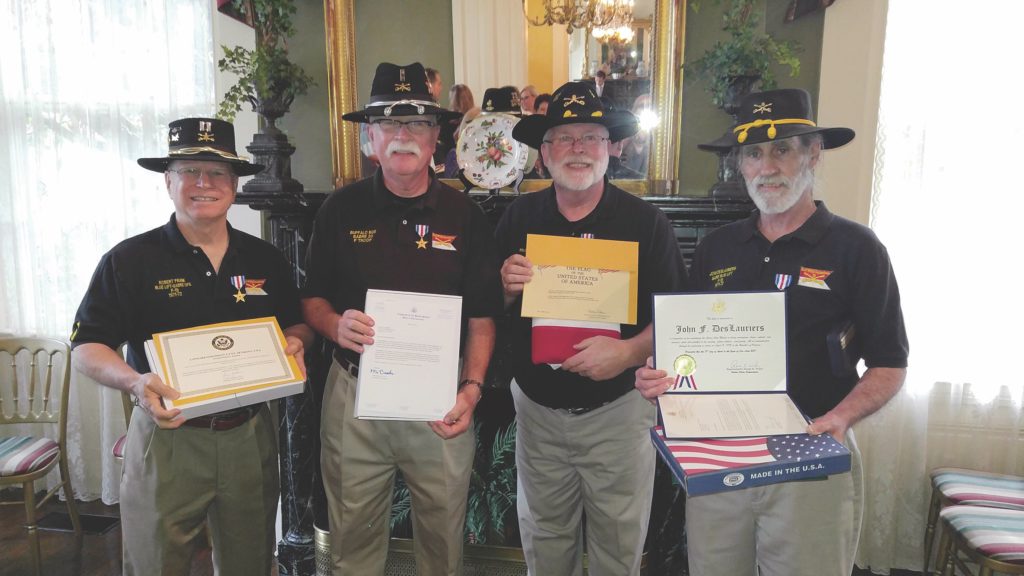
In the second Cobra of the Pink Team, Capt. Ron Timberlake finished the afternoon’s work by destroying the C-130 to prevent enemy intelligence gathering and silence the emergency locator beacon. A salvo of 2.75-inch rockets from his Cobra did the trick.
After discharging their grateful passengers at Lai Khe, Frank and his crew flew to the refueling site. Shearer noted that several rounds had hit the Huey during the rescue. Once refueled, the Pink Team’s helicopters went back to their reconnaissance missions until darkness fell.
All seven members of the C-130 crew had been rescued from a crash that did not appear survivable. They were also saved from almost certain capture or death at enemy hands. All seven lived out full lives—except for one tragic loss. ARVN soldier Kiem recovered from his wounds but died several years later in a communist reeducation camp. On April 18, 2017, Frank, Monette, Shearer and Deslauriers were awarded belated Silver Stars for their actions 45 years earlier.
Dr. Thomas Ward is an associate professor at the U.S. Command and General Staff College at Fort Leavenworth, Kansas.
This article appeared in the June 2022 issue of Vietnam magazine.

